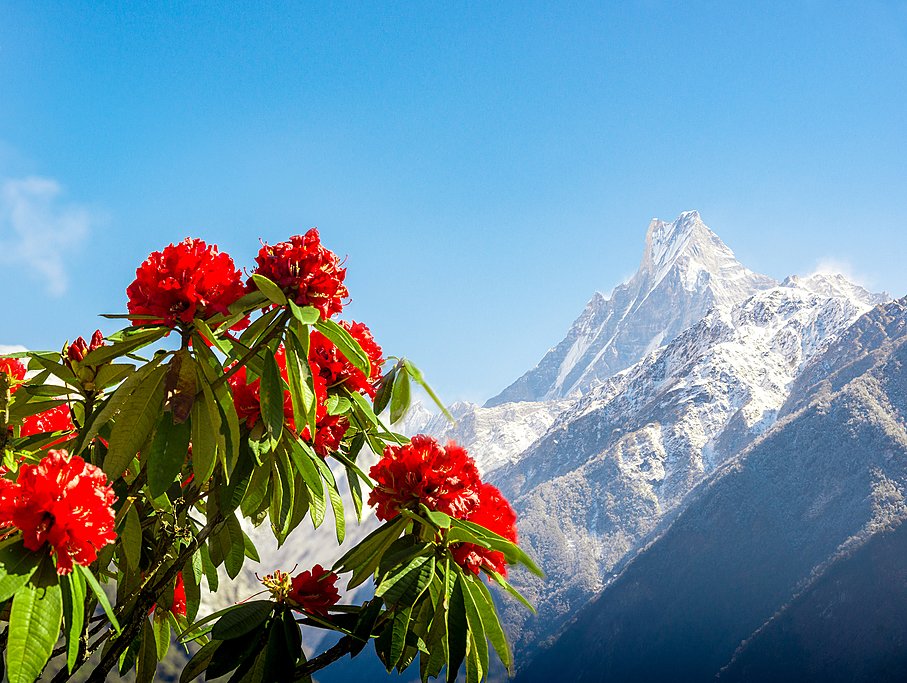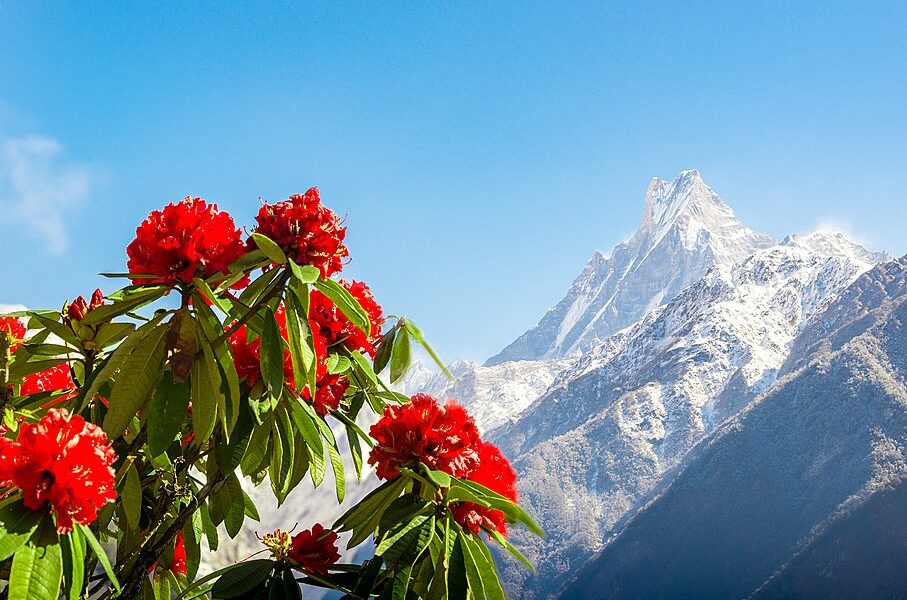
April is perhaps the most popular month for travel in Nepal, with prime weather for outdoor adventures at any altitude. The most popular trekking routes are at their best and busiest—you’ll need to book well in advance to secure your spot on the trail. While you won’t have the country all to yourself, you’ll find that this is peak season for good reason.
Nepal in April offers a tapestry of experiences, from the steamy plains to the soaring heights of the Himalaya. Understanding the nuances of this time of year can help you craft the perfect adventure. Here’s a detailed look at what awaits you in Nepal during April, ensuring you’re well-prepared for your journey.
**Weather in Nepal During April**
Nepal is a land of dramatic geographical contrasts, and this is vividly reflected in its weather patterns. In April, the country experiences a significant variation in temperature and climate across its different regions. From the low-lying plains of the Terai, where humidity and heat can be intense, to the mid-hills encompassing Kathmandu and Pokhara, and finally, to the towering peaks of the high Himalaya, the weather differs greatly.
Most of Nepal experiences warm temperatures in April. The higher altitude areas within the mountains are no exception and enjoy warmer and sunny days, making for pleasant trekking conditions, although evenings will still be cooler. Kathmandu and Pokhara, nestled in the mid-hills, commonly see temperatures climbing into the 90s Fahrenheit during the daytime. Rainfall is generally scarce during this month, but winds can pick up, often carrying dust, especially as spring progresses. Travelers should be prepared for the potential of dusty conditions, particularly in urban areas. The Terai region, situated in the southern part of Nepal, can be uncomfortably hot in April, so appropriate clothing and hydration are crucial when visiting this area.
**Navigating Crowds and Costs**
April is considered one of the peak tourist seasons in Nepal, alongside October. This means that certain areas, especially popular trekking destinations like the Everest region and the Annapurna region, experience a higher volume of travelers. While Nepal generally doesn’t suffer from debilitating overcrowding, these specific trekking areas do see a noticeable increase in foot traffic.
It’s advisable to book accommodations well in advance, especially in popular trekking areas, as the best lodges tend to fill up quickly during peak season. Similarly, domestic flights and long-distance tourist buses also require early booking to secure your preferred travel times and dates. Many hotels and guesthouses implement peak-season rates, which are generally higher than those offered during the quieter, low-season months. Planning ahead is essential to manage your budget and ensure a smooth travel experience.
**Exploring the Trekking Trails**
April is often considered the ideal time to explore Nepal’s famed trekking trails. The conditions are generally dry, allowing for easier and safer hiking. The views are typically clear, although perhaps not quite as consistently reliable as in October, which often boasts exceptional visibility. Daytime temperatures are warm and pleasant, even at higher altitudes, making trekking a comfortable and enjoyable experience.
Spring is an excellent time to undertake treks that involve crossing high mountain passes, as the weather is generally more stable and predictable. While hiring a guide is always recommended when trekking in Nepal, their assistance becomes particularly valuable during peak season. Guides can help secure accommodation in the most popular areas, navigate busy trails, and provide valuable insights into the local culture and environment.
**Destinations to Discover**
Treks in the high Himalaya and the relatively drier rainshadow areas of the Himalaya, such as Mustang and Upper Dolpo, are particularly enjoyable in April. These regions offer stunning landscapes and unique cultural experiences. While nighttime temperatures can still dip to freezing levels at higher altitudes, daytime conditions are typically sunny and warm, creating ideal trekking conditions.
Kathmandu, while culturally rich and fascinating, can become very hot and dusty in April as it approaches the monsoon season. For those seeking cleaner air and cooler temperatures, venturing out to the hills, mountains, and rivers surrounding Kathmandu is a welcome escape. Destinations such as Nagarkot or Dhulikhel offer breathtaking views and a respite from the city’s heat and dust.
**Experiences to Embrace**
Trekking in the mountains is undoubtedly the top reason to visit Nepal in April. Whether you prefer camping under the stars or staying in comfortable teahouses along the trails, most regions are accessible and at their most beautiful during this time of year. For travelers with an interest in flora and botany, trekking through the colorful rhododendron forests, which bloom profusely in April, is a truly unforgettable experience. The Everest Region also beckons and for more information on this, checking out Everest Base Camp can offer tips, weather details and much more.
April also marks the beginning of the brief Everest climbing season, a narrow window of opportunity when conditions are considered optimal for ascending the world’s highest peak. If tackling Everest seems a bit ambitious, April is also an excellent time to consider attempting a trekking peak, such as Island Peak or Mera Peak. These peaks offer a challenging yet rewarding experience for experienced trekkers and climbers.
For those seeking alternative activities, white-water rafting and kayaking trips are popular options in April. However, it’s worth noting that water levels tend to be lower in the months leading up to the monsoon season, so some rivers are better suited for white-water activities than others. Mountain biking is another enjoyable activity, as the trails are typically dry and in good condition for riding.
**Festivals and Events**
Nepal’s traditional festivals, deeply rooted in both Hindu and Buddhist traditions, generally follow a lunar calendar. This means that the dates of these festivals can vary from year to year, sometimes falling in March or May instead of April. However, some festivals are commonly celebrated in April, offering visitors a glimpse into Nepal’s rich cultural heritage.
One notable festival is Rato Machchendranath, a significant event celebrated in Patan. During this festival, a statue of the deity Machchendranath is paraded through the streets in a massive chariot for several days, drawing large crowds of devotees and spectators.
Nepali New Year is another major celebration, particularly vibrant in Bhaktapur, where the Bisket Jatra chariot festival takes place. This festival is marked by lively processions, traditional music, and various cultural performances.
Buddha Jayanti, commemorating the birth of Buddha, is celebrated with particular enthusiasm in Buddhist communities, especially in areas such as Boudhanath in Kathmandu. Monasteries are decorated with colorful prayer flags, and devotees participate in religious ceremonies and processions.
**Suggested Itineraries**
For those planning a trip to Nepal in April, several itineraries offer unique and unforgettable experiences.
Lower Mustang Trek provides a great option for those with limited time. It allows one to experience the stunning beauty of Mustang, while avoiding areas of the country with high-temperatures. This area also offers a well-developed network of trails featuring comfortable teahouses. The area of Mustang is part of an ancient trade route to Tibet, up the Kali Gandaki river and offers a unique cultural experience.
Upper Dolpo Trek is a long and arduous journey, is an unforgettable adventure. This trek requires a high level of fitness, stamina, and careful preparation. However, the rewards are immeasurable: the chance to immerse oneself in Tibetan Buddhist culture, explore some of the oldest monasteries in the country, witness the spectacular beauty of Lake Phoksundo, observe rare wildlife, and experience a profound sense of being in the wilderness.
Climb Island Peak is for those seeking to test their climbing skills on a Himalayan peak. Island Peak, standing at 20,305 feet, offers a challenging yet rewarding experience.
B-1736

